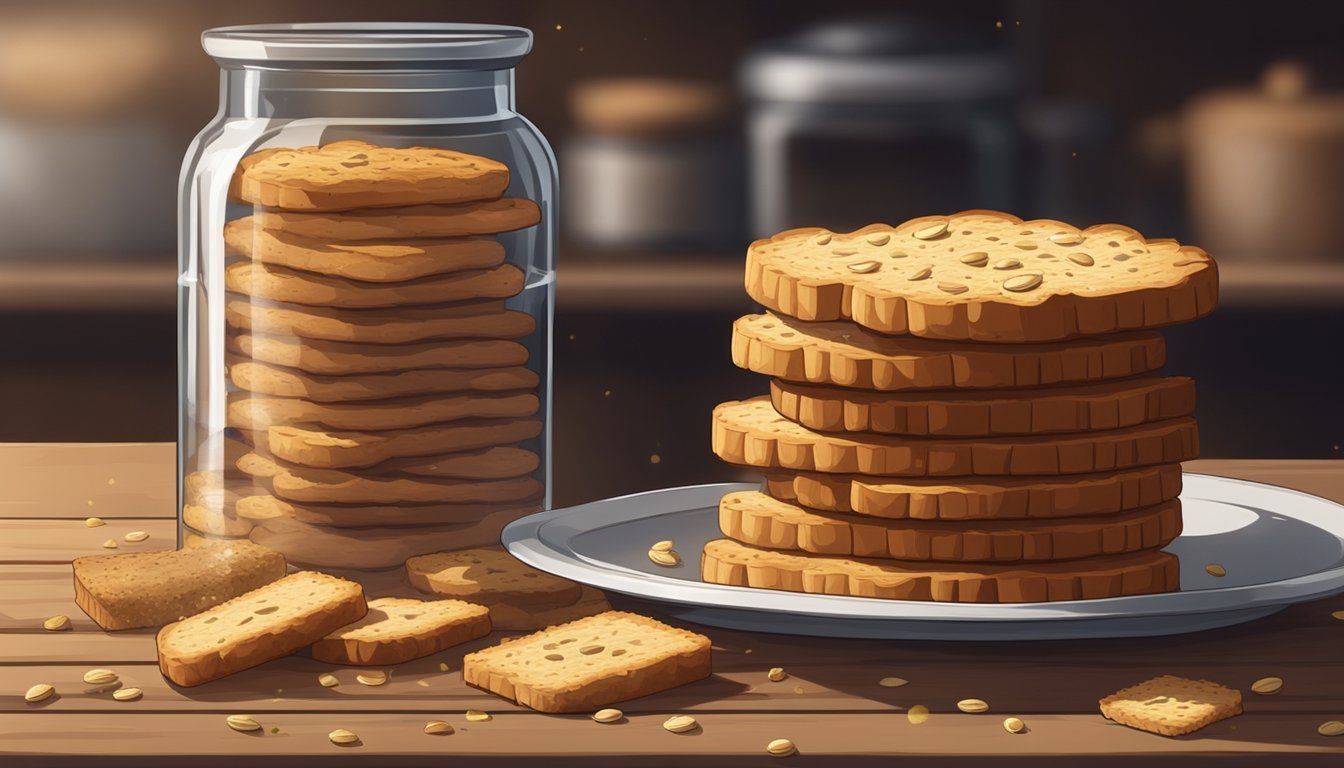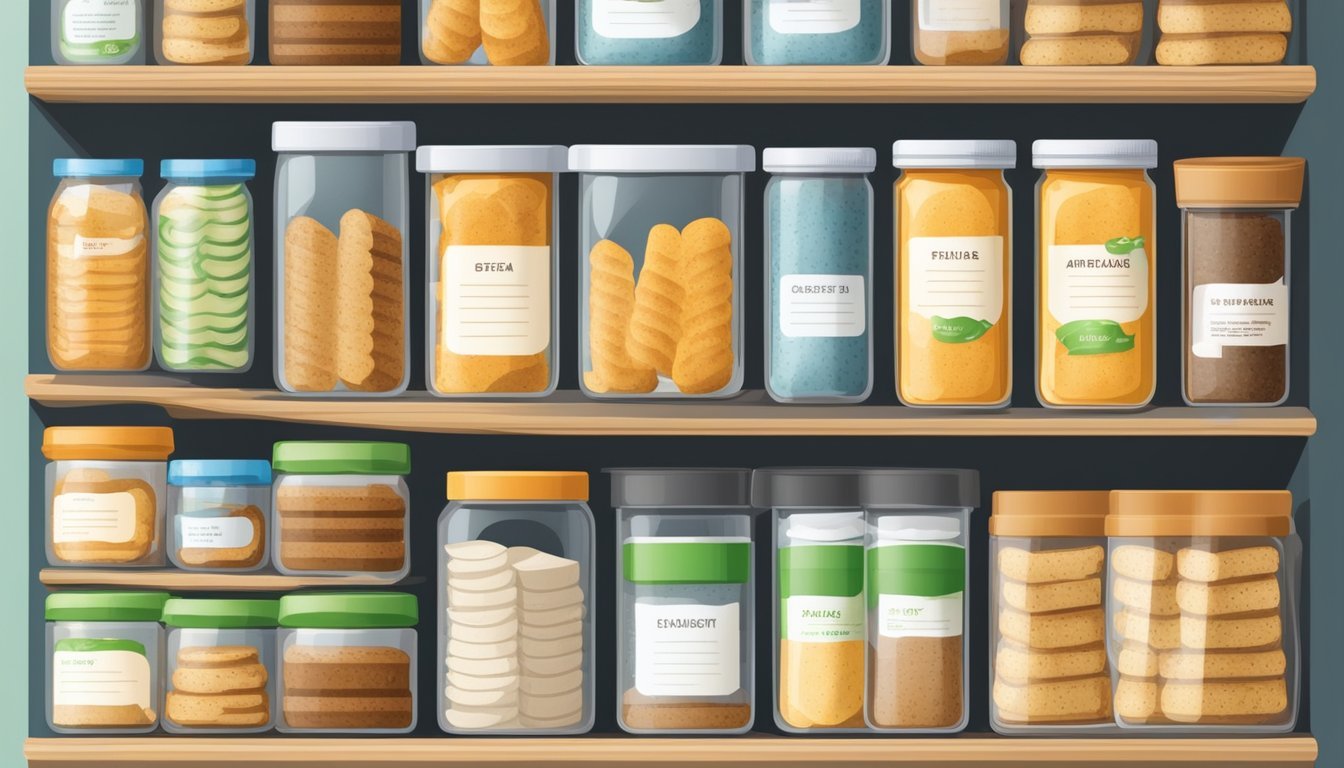Rusk Shelf Life: How Long Do They Last and Storage Tips
Shelf Life and Storage Tips
Rusk, a hard and dry biscuit or a type of double-baked bread (how long does bread last?), has been enjoyed as a sturdy, long-lasting snack for many years. Its durability comes from its unique baking process, where it is initially baked as bread and then sliced and baked again to remove moisture. This results in a crispy, shelf-stable product that is ideal for a variety of uses, from a simple snack to a dip for tea or coffee.
The shelf life of rusk is considerably longer than fresh bread due to the low moisture content that inhibits the growth of molds and spoilage bacteria. When properly stored in a cool, dry place, rusks can last for several months without losing their quality. Factors such as the ingredients used in the recipe, the storage environment, and the packaging can all influence the longevity of rusks. Typically, a homemade rusk recipe can produce a finished product that maintains its freshness for a few weeks to a few months. Commercially prepared rusks, like those from known brands, often have a longer shelf life owing to preservatives and optimized baking processes designed to maximize dryness and shelf stability.
Definition and Characteristics of Rusk
In this section, the discussion centers around what constitutes a rusk, its key components, and the various types one might encounter.
What Is a Rusk?
A rusk is a hard, dry biscuit or a twice-baked bread. It is traditionally made by baking bread dough, slicing it, and then baking the slices again until they are crisp and dry. These products serve not only as a standalone snack but also as an important functional ingredient in culinary preparations such as sausage making, where they act as a binding agent.
Key Ingredients
Flour: The primary component, often wheat-based.
Binding Agent: Ingredients like yeast or baking powder which provide leavening.
Salt: Enhances flavor and extends the shelf-life of rusk.
Additional flavors may include sugar (how long does sugar last?), spices, herbs, or seeds to introduce a variety of tastes.
Types of Rusk
There are different types of rusk categorized based on their texture and size, which influence their culinary uses:
Sukhary: Originating from Azerbaijan, often made from stale bread or buns.
Pinhead, Medium, and Coarse Rusk: These indicate the granularity and are particularly relevant in sausage making for texture.
Cake Rusk: A sweet variety used commonly as a breakfast item, made with minimal sugar.
Baking Process and Techniques
The rusk baking process involves specific techniques to achieve its notable crispy texture; from dough preparation, through a distinctive double-baking method, to proper cooling and storage.
Preparation of Dough
The dough for rusks starts with key ingredients: cake flour, salt, sugar, eggs, melted butter, and a leavening agent like baking powder or yeast in some recipes. Accurate measurement of ingredients is crucial for the consistency and texture of the rusks. Mixing must be done just enough to combine ingredients without overworking the dough to ensure a tender crumb.
Baking and Double-Baking
Once the dough is prepared, it is shaped and placed on a baking sheet before entering the oven for its first bake, which sets the initial structure of the bread. After this, rusks undergo a unique double-baking process. The bread is cut into slices and returned to the oven to dry out at a very low temperature. This could be done overnight, resulting in rusks that are firm, crispy, and durable.
Cooling and Storage
After the second bake, the rusks are carefully removed from the oven and placed on a wire rack to cool, which helps maintain their crispness by allowing air to circulate around them. Once cooled, they should be stored in an airtight container at room temperature if they're to be consumed within a week, or frozen for longer shelf life. This method prevents the rusks from absorbing moisture and becoming stale.
Shelf Life and Preservation
When discussing the longevity of rusks, one must consider various factors that influence their shelf life and acknowledge the methods that can extend it. Adhering to proper storage protocols is imperative for preservation.
Factors Affecting Shelf Life
The shelf life of rusks is greatly affected by their composition and the packaging materials used. They can generally last for several months when packaged correctly. The materials should possess optimal barrier properties to protect against moisture and air, which can deteriorate the product's quality. The physical attributes of rusks, such as moisture content, and the use of preservatives or fiber content, also play a crucial role in their shelf life.
Packaging Materials: The use of packaging that has good barrier properties to moisture and oxygen can extend the shelf life.
Moisture Content: Lower moisture content in rusks usually equates to a longer shelf life as it reduces the risk of mold growth.
Proper Storage Methods
To maximize the shelf life of rusks, they should be stored in an airtight or sealed container. This helps to maintain their crispiness and prevents the ingress of moisture and other contaminants.
Airtight Storage: Placing rusks in an airtight container can help in preserving their texture and freshness.
Environmental Conditions: Rusks should be kept in a cool, dry place away from direct sunlight to prevent deterioration.
Serving and Uses
Rusk plays a versatile role in culinary traditions, being both a snack on its own and a component in various dishes. It demonstrates an ability to complement beverages and act as a foundation for numerous toppings.
Traditional Pairings
Rusk traditionally finds its esteemed place alongside beverages such as tea and coffee. Its crispy texture and absorbent nature make it an excellent companion to these hot drinks, often served as a breakfast item or midday snack.
Tea: A plain rusk dipped in tea is a comforting, simple pleasure.
Coffee: When served with coffee, rusk tends to absorb the flavors, enriching its own taste.
In addition to beverages, rusk serves well as an appetizer. It acts as a carrier for various toppings:
Butter: A common spread that enhances the rusk’s flavor and adds a creamy texture.
Meat: It can hold fine slices of meat or pâté for a savory treat.
Creative Serving Ideas
Chefs and home cooks have come up with imaginative ways to use rusk, far beyond its traditional serving methods.
Breakfast: Crushed rusk can serve as a crunchy topping on yogurt or oatmeal.
Sandwiches: With a sturdy structure, it can work as bread in open-faced sandwiches, layered with ingredients like avocado or smoked salmon.
Salads: Adding crumbled rusk to salads can introduce an enjoyable crunch.
By utilizing rusk as a component in various dishes, its utility in the kitchen is elevated, making it a staple for both its preserving qualities and its culinary versatility.
Recipes and Variations
In the realm of Rusks, the classic recipe is a cornerstone, and variations serve to enhance the experience with diverse flavors. Each recipe shares a common foundation yet allows for personal taste preferences through the addition of various ingredients.
Classic Rusk Recipe
The classic Rusk recipe involves a process of creating a basic dough that contains cake flour, granulated sugar, melted butter, and eggs. A leavening agent such as baking powder is essential to provide the necessary rise. This dough is then baked, cut into desired shapes, and baked again at a low temperature to achieve the distinctive dry and crisp texture that Rusks are known for.
Ingredients:
Cake flour
Granulated sugar
Melted butter
Eggs
Baking powder
Method:
Combine dry ingredients.
Incorporate melted butter and eggs.
Bake until golden brown.
Slice and bake again to dry.
Variations in Flavors
The versatility of Rusk recipes allows for a range of flavors to suit any palate. One can venture into chocolate Rusks by incorporating cocoa powder into the dough or creating a decadent chocolate drizzle on top after the second bake. For those inclined towards aromatic spices, cardamom can be added to infuse the Rusks with its distinctive warm flavor. Each variation takes the simple base of a Rusk and elevates it to a treat that transcends the ordinary.
Chocolate Rusk:
Add cocoa powder to the dough.
Optionally, drizzle with melted chocolate post-bake.
Cardamom Rusk:
Infuse the dough with ground cardamom during mixing.
The spice's unique taste enhances the Rusk's flavor profile.
Nutritional Information and Health Benefits
Rusk, a twice-baked bread, is commonly consumed as a tea-time snack. It's known for its crispy texture and long shelf life compared to regular bread. Rusks are made by removing most of the water content, which is what allows them to last longer.
Nutrients Per Serving (Typically 10g of rusk):
Calories: 41
Total Fat: 0.7g
Saturated Fat: 0.1g
Polyunsaturated Fat: 0.2g
Monounsaturated Fat: 0.3g
Cholesterol: 7.8mg
Sodium: 25mg
Total Carbohydrates: 7.2g
Protein: 1.4g
Minerals:
Calcium: 2.7mg
Iron: 0.3mg
Potassium: 24.5mg
Rusks consist of a fair amount of carbohydrates, which provide a quick source of energy. They contain a small amount of protein and are low in fat, which can partially contribute to a balanced diet when consumed in moderation.
In terms of health benefits, while rusks can be comforting with tea or coffee, their benefits are limited due to the high carbohydrate content and low moisture content, potentially affecting digestion and gut health. They do contain some fiber, although it is not a significant amount. Consumers seeking higher dietary fibers should look for rusks made with whole grains or added fibers.
Consuming high-fiber rusks in moderate amounts can aid in digestion due to the presence of fibers, albeit limited. It's essential for consumers to balance their intake of rusks with adequate water to maintain proper digestion.
It's worth noting that, although rusk is low in water content, staying hydrated is crucial for maximizing the digestive benefits and maintaining overall health, especially when consuming dry snacks like rusk.







